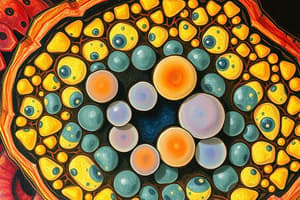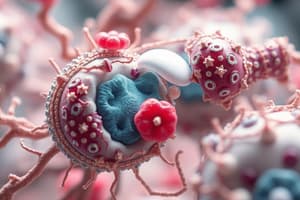Podcast
Questions and Answers
Which mechanism is responsible for transporting proteins from the cytosol to the nucleus?
Which mechanism is responsible for transporting proteins from the cytosol to the nucleus?
- Transport across membrane
- Bidirectional movement
- Gated transport (correct)
- Coated with ribosomes
What happens to proteins that lack sorting signals?
What happens to proteins that lack sorting signals?
- They are transported to mitochondria
- They are transported to the nucleus
- They stay in the cytosol (correct)
- They diffuse freely through the membrane
Which organelle captures proteins from the cytosol during synthesis and is coated with ribosomes?
Which organelle captures proteins from the cytosol during synthesis and is coated with ribosomes?
- Nucleus
- Mitochondria
- Golgi apparatus
- Endoplasmic reticulum (ER) (correct)
What type of transport is needed for molecules like DNA and RNA polymerases to move across nuclear pores?
What type of transport is needed for molecules like DNA and RNA polymerases to move across nuclear pores?
In which mechanism does the transporter protein need to unfold for guidance across the hydrophobic interior of the membrane?
In which mechanism does the transporter protein need to unfold for guidance across the hydrophobic interior of the membrane?
Which type of proteins are transported via nuclear pores guided by signal sequences with the help of soluble receptor proteins in the cytosol?
Which type of proteins are transported via nuclear pores guided by signal sequences with the help of soluble receptor proteins in the cytosol?
What directs proteins into different organelles based on their amino acid sequence?
What directs proteins into different organelles based on their amino acid sequence?
What is the mechanism of transfer for soluble proteins from cytosol to ER?
What is the mechanism of transfer for soluble proteins from cytosol to ER?
What initiates translocation and contains a signal sequence as well as a stop transfer sequence for transmembrane proteins?
What initiates translocation and contains a signal sequence as well as a stop transfer sequence for transmembrane proteins?
What is responsible for shaping vesicles for transport and capturing molecules?
What is responsible for shaping vesicles for transport and capturing molecules?
Which proteins ensure specificity and docking of vesicles to target membranes, catalyzing membrane fusion?
Which proteins ensure specificity and docking of vesicles to target membranes, catalyzing membrane fusion?
What contributes to recognition and protection of proteins during secretion?
What contributes to recognition and protection of proteins during secretion?
Which mechanism involves ribosomes being brought down to the ER membrane by SRP?
Which mechanism involves ribosomes being brought down to the ER membrane by SRP?
What occurs for transmembrane proteins during transport?
What occurs for transmembrane proteins during transport?
What is the main difference between constitutive and regulated secretion?
What is the main difference between constitutive and regulated secretion?
Soluble proteins and transmembrane proteins are transferred from cytosol to ER using the same mechanism
Soluble proteins and transmembrane proteins are transferred from cytosol to ER using the same mechanism
Signal peptidases cleave off the signal sequence on the protein, and the N-terminal sequence initiates translocation
Signal peptidases cleave off the signal sequence on the protein, and the N-terminal sequence initiates translocation
Co-translational transport occurs for transmembrane proteins, with signal recognition particle (SRP) recognizing the signal sequence
Co-translational transport occurs for transmembrane proteins, with signal recognition particle (SRP) recognizing the signal sequence
Vesicular transport relies on ATP and membrane budding, but not membrane fusion
Vesicular transport relies on ATP and membrane budding, but not membrane fusion
Each transport vesicle carries a mix of different proteins to its destination
Each transport vesicle carries a mix of different proteins to its destination
Soluble proteins and transmembrane proteins are both made in the ER and fully transported through its membrane, ending up in its lumen
Soluble proteins and transmembrane proteins are both made in the ER and fully transported through its membrane, ending up in its lumen
Transmembrane proteins partially transfer across the membrane, remain embedded in it, and go through the protein translocator
Transmembrane proteins partially transfer across the membrane, remain embedded in it, and go through the protein translocator
Each transport vesicle carries only appropriate proteins to its destination
Each transport vesicle carries only appropriate proteins to its destination
Constitutive secretion occurs continuously, while regulated secretion requires signals to initiate
Constitutive secretion occurs continuously, while regulated secretion requires signals to initiate
Glycosylation protects proteins from degradation and aids in recognition during secretion
Glycosylation protects proteins from degradation and aids in recognition during secretion
Flashcards are hidden until you start studying
Study Notes
-
Soluble proteins and transmembrane proteins are transferred from cytosol to ER with different mechanisms
-
Soluble proteins are made in ER, fully transported through its membrane, and end up in its lumen
-
Signal peptidases cleave off the signal sequence on the protein, and the N-terminal sequence initiates translocation
-
Transmembrane proteins partially transfer across the membrane, remain embedded in it, and go through the protein translocator
-
The N-terminal sequence initiates translocation and contains a signal sequence as well as a stop transfer sequence
-
Co-translational transport occurs for soluble proteins, with signal recognition particle (SRP) recognizing the signal sequence
-
ER appears rough due to ribosomes being brought down to the membrane by SRP
-
Vesicular transport, an alternative method for protein transport, relies on ATP and membrane budding and fusion
-
Each transport vesicle only carries appropriate proteins to its destination
-
Transmembrane proteins stay in the membrane of the vesicle during transport and merge with the destination compartment membrane
-
ER and Golgi are involved in the secretory pathway
-
Constitutive and regulated secretion occur through different mechanisms, with regulated secretion requiring signals and constitutive secretion being continuous
-
Proteins undergo modifications during secretion, such as glycosylation in the ER and Golgi
-
Glycosylation protects proteins from degradation and aids in recognition
-
Clathrin and COP proteins coat vesicles and help shape them for transport and capture molecules
-
Rab proteins and SNAREs ensure specificity and docking of vesicles to target membranes, catalyzing membrane fusion.
-
Soluble proteins and transmembrane proteins are transferred from cytosol to ER with different mechanisms
-
Soluble proteins are made in ER, fully transported through its membrane, and end up in its lumen
-
Signal peptidases cleave off the signal sequence on the protein, and the N-terminal sequence initiates translocation
-
Transmembrane proteins partially transfer across the membrane, remain embedded in it, and go through the protein translocator
-
The N-terminal sequence initiates translocation and contains a signal sequence as well as a stop transfer sequence
-
Co-translational transport occurs for soluble proteins, with signal recognition particle (SRP) recognizing the signal sequence
-
ER appears rough due to ribosomes being brought down to the membrane by SRP
-
Vesicular transport, an alternative method for protein transport, relies on ATP and membrane budding and fusion
-
Each transport vesicle only carries appropriate proteins to its destination
-
Transmembrane proteins stay in the membrane of the vesicle during transport and merge with the destination compartment membrane
-
ER and Golgi are involved in the secretory pathway
-
Constitutive and regulated secretion occur through different mechanisms, with regulated secretion requiring signals and constitutive secretion being continuous
-
Proteins undergo modifications during secretion, such as glycosylation in the ER and Golgi
-
Glycosylation protects proteins from degradation and aids in recognition
-
Clathrin and COP proteins coat vesicles and help shape them for transport and capture molecules
-
Rab proteins and SNAREs ensure specificity and docking of vesicles to target membranes, catalyzing membrane fusion.
-
Soluble proteins and transmembrane proteins are transferred from cytosol to ER with different mechanisms
-
Soluble proteins are made in ER, fully transported through its membrane, and end up in its lumen
-
Signal peptidases cleave off the signal sequence on the protein, and the N-terminal sequence initiates translocation
-
Transmembrane proteins partially transfer across the membrane, remain embedded in it, and go through the protein translocator
-
The N-terminal sequence initiates translocation and contains a signal sequence as well as a stop transfer sequence
-
Co-translational transport occurs for soluble proteins, with signal recognition particle (SRP) recognizing the signal sequence
-
ER appears rough due to ribosomes being brought down to the membrane by SRP
-
Vesicular transport, an alternative method for protein transport, relies on ATP and membrane budding and fusion
-
Each transport vesicle only carries appropriate proteins to its destination
-
Transmembrane proteins stay in the membrane of the vesicle during transport and merge with the destination compartment membrane
-
ER and Golgi are involved in the secretory pathway
-
Constitutive and regulated secretion occur through different mechanisms, with regulated secretion requiring signals and constitutive secretion being continuous
-
Proteins undergo modifications during secretion, such as glycosylation in the ER and Golgi
-
Glycosylation protects proteins from degradation and aids in recognition
-
Clathrin and COP proteins coat vesicles and help shape them for transport and capture molecules
-
Rab proteins and SNAREs ensure specificity and docking of vesicles to target membranes, catalyzing membrane fusion.
Studying That Suits You
Use AI to generate personalized quizzes and flashcards to suit your learning preferences.




